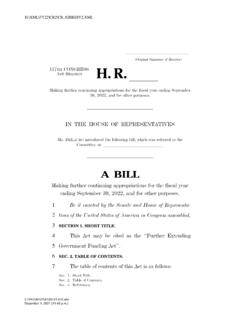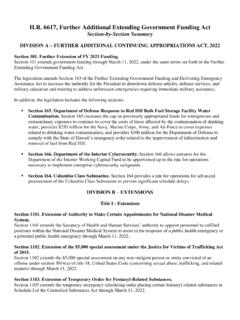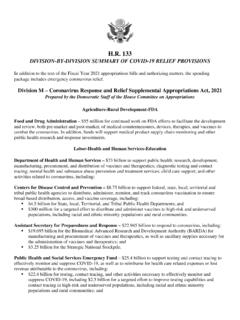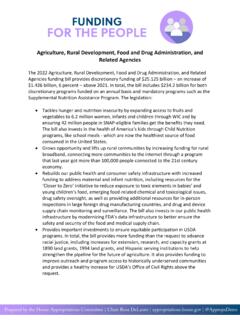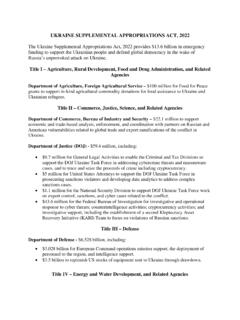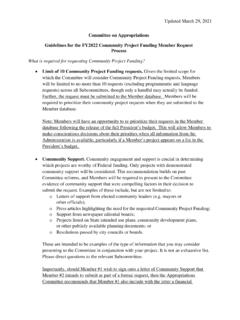Transcription of H.R. 133 - United States House Committee on Appropriations
1 133. DIVISION-BY-DIVISION SUMMARY OF Appropriations provisions . 133 totals $ trillion and reflects conference agreements for the FY 2021 Appropriations bills. It furthers House Democrats' commitment to investing For The People with substantial increases to non-defense spending alongside small increases for defense-related programs. In total, the package provides: $ billion in base defense funding, a $5 billion increase over FY 2020;. $ billion in nondefense funding, an $20 billion increase over FY2020;. $77 billion for Overseas Contingency Operations (OCO) $69 billion for defense activities and $8. billion for nondefense activities; and An additional $ billion in emergency funding related to the COVID-19 pandemic, $ billion in funding for wildfire suppression activities, $ billion for program integrity initiatives, and $474.
2 Million medical research associated with the 21st Century Cures Act. In the last year of the Budget Control Act caps, after accounting for rescissions and emergency spending, the package includes non-defense funding that is $15 billion above the levels set in the Bipartisan Budget Act of 2019. Division A Agriculture-Rural Development-FDA. Overview: The Agriculture, Rural Development, Food and Drug Administration, and Related Agencies bill funds agencies and programs within the Department of Agriculture, the Farm Credit Administration, and the Food and Drug Administration. The FY 2021 bill provides $ billion in discretionary funding, $217 million above the FY 2020 enacted level.
3 In addition, it provides the latest estimates for mandatory programs required by law. The bill funds important agricultural and food programs and services, including food and medical product safety, animal and plant health programs, rural development, farm services, agricultural trade, financial marketplace oversight, and nutrition programs, both domestic and international. Bill Summary: Rural Development and Infrastructure The bill provides a total of almost $ billion for rural development programs. These programs help create an environment for economic growth by providing business and housing opportunities and building sustainable rural infrastructure for the modern economy.
4 Critical Infrastructure The legislation includes responsible investments in infrastructure to help rural areas of the country access basic utilities. This includes $ billion for rural water and waste program loans, and more than $620 million in water and waste grants for clean and reliable drinking water systems and sanitary waste disposal systems. An additional $ billion in loan authority is provided for rural electric and telephone infrastructure loans. Rural Broadband The legislation invests more than $730 million in the expansion of broadband service to provide economic development opportunities and improved education and healthcare services, including $635 million for the ReConnect program, an increase of $80 million over FY 2020.
5 These significant investments in broadband reflect a commitment to enabling Americans in rural communities to access digital tools necessary to improve health, educational, and economic outcomes. Rural Housing Loans and Rental Assistance The bill provides a total of $24 billion in loan authority for the Single Family Housing Guaranteed Loan Program. The bill includes $1 billion in direct single family housing loans, meeting the estimated need for these loans, which provide home loan assistance to low-income rural families, many of whom would have few loan options for purchasing a home because of their geographical location.
6 In addition, $ billion is provided for rental assistance for affordable rental housing for low-income families and the elderly in rural communities for renewal of all existing rental assistance contracts. Food and Nutrition Programs The legislation contains discretionary funding, as well as mandatory funding required by law, for food and nutrition programs within USDA. This includes funding for the Special Supplemental Nutrition Program for Women, Infants, and Children (WIC), the Supplemental Nutrition Assistance Program (SNAP), and child nutrition programs. WIC The bill provides $6 billion in discretionary funding for WIC, which fully funds participation this year.
7 This includes $90 million for the breastfeeding counselor program. Child nutrition programs The bill provides for $ billion in required mandatory funding for child nutrition programs. This is $ billion above the FY 2020 enacted level. This funding will provide free or reduced-price school lunches and snacks for children who qualify for the program. The bill provides approximately $552 million for the Summer Food Service Program to ensure low-income children continue to receive nutritious meals when school is not in session. In addition, the bill provides $42. million for the Summer EBT program, $30 million for school kitchen equipment grants, and $21 million for the WIC farmers market nutrition program.
8 SNAP The bill provides for $114 billion in required mandatory spending for SNAP. This fully funds participation as well as the SNAP enhanced allotments authorized by the Families First Act. International Food Assistance Programs The legislation contains $ billion for international food aid and for the promotion of agricultural exports overseas. This includes $ billion for Food for Peace grants and $230 million for the McGovern-Dole International Food for Education and Child Nutrition program. This represents the highest-ever level of funding for these two vital programs. These programs work to reduce famine and increase food security overseas.
9 Food and Drug Administration (FDA) The FDA receives a total of $ billion in discretionary funding in the bill, $43 million above the 2020 enacted level. Total funding for the FDA, including user fees, is $ billion. Within this total, the Committee provides targeted increases for medical product and food safety activities, including new initiatives to advance new influenza vaccine manufacturing technologies and leverage emerging technologies to monitor food and medical product safety. Funding is also included to support the development of a framework for regulating CBD products, continue FDA's efforts to enable faster responses to foodborne illness outbreaks, and increase the safety and cybersecurity of medical devices.
10 In addition, the bill includes a strong focus on continuing FDA's efforts to inspect foreign food and drug products. The bill also appropriates $70 million to accelerate medical product development as authorized in the 21st Century Cures Act. Food Safety and Inspection Service The legislation includes $ billion for food safety and inspection programs. These mandatory inspection activities help to ensure safe, meat and poultry on American tables. The funding provided will maintain nearly 8,800 frontline inspection personnel for meat, poultry, and egg products at more than 6,400 facilities across the country.



